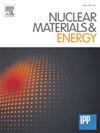氦对铁辐射膨胀中温度-位移速率等效的影响:改进的随机簇动力学研究
IF 2.7
2区 物理与天体物理
Q1 NUCLEAR SCIENCE & TECHNOLOGY
引用次数: 0
摘要
在核能系统中,了解辐照下的材料行为(如膨胀)对于确保长期稳定性和安全性至关重要。虽然直接中子辐照实验存在重大挑战,但离子辐照是模拟中子诱导损伤的另一种加速方法。然而,中子辐照和离子辐照在嬗变诱导的大量氦(He)方面存在根本差异,中子辐照的置换率明显低于离子辐照实验。因此,两种辐照方法在肿胀中的等效性以及He的作用仍然知之甚少。本研究提出了一种优化的随机聚类动力学(SCD)框架,该框架将动态速率表更新与小缺陷聚类的预存储特性的双重机制策略相结合,同时实时计算大缺陷聚类,从而解决了传统随机聚类动力学方法中持久存储效率的权衡问题,同时提高了高剂量辐射损伤演化(高达10 dpa)的模拟效率。通过改进的方法,我们系统地研究了温度、位移速率、He和空位迁移能垒(EVm)对膨胀行为的影响。结果表明,这些因素对肿胀有显著影响。其中,纯铁的溶胀随温度升高先增大后减小,溶胀峰值温度与驱替速率的对数呈正相关。高驱替率大大扩大了膨胀的温度范围。增加团簇分辨率(即在溶胀计算中考虑较大的空位团簇)会使峰值溶胀温度升高,而较高的辐照剂量则会降低峰值溶胀温度。he诱导的协同损伤促进了大空位团簇的形成,扩大了溶胀温度范围,同时导致溶胀程度高于单纯的位移损伤。此外,EVm(由氦和溶质效应增强的空位迁移能)的增加导致峰值溶胀温度升高,溶胀程度降低。本研究还探讨了在不同位移速率下实现等效辐照损伤所需的温度变化,为模拟中子辐照中离子辐照等效的温度选择标准提供了见解。这一发现阐明了膨胀机制,并为中子和离子辐照等效的温度控制奠定了基础。本文章由计算机程序翻译,如有差异,请以英文原文为准。
Helium effect on temperature-displacement rate equivalence in radiation-induced swelling of iron: A study by improved stochastic cluster dynamics
In nuclear energy systems, understanding material behavior (e.g., swelling) under irradiation is critical for ensuring long-term stability and safety. While direct neutron irradiation experiments pose significant challenges, ion irradiation serves as an alternative accelerating method for simulating neutron-induced damage. However, fundamental differences exist between neutron and ion irradiation in terms of substantial helium (He) induced by transmutation and significantly lower displacement rate in neutron irradiation than that of ion irradiation experiments. The equivalence between the two irradiation approaches in swelling, as well as the role of He, thus remains poorly understood. This study presents an optimized stochastic cluster dynamics (SCD) framework that combines dynamic rate table updating with a dual-regime strategy of pre-storing properties of small defect clusters while computing large clusters in real time, thereby resolving the persistent memory efficiency trade-off in conventional SCD approaches and meanwhile improving simulation efficiency for high-dose irradiation damage evolution (up to 10 dpa). By using the enhanced methodology, we systematically investigated the effects of temperature, displacement rate, He and vacancy migration energy barrier () on swelling behavior. The results reveal that these factors significantly influence swelling. Specifically, the swelling of pure iron initially increases and then decreases with rising temperature, with the peak swelling temperature positively correlated with the logarithm of the displacement rate. High displacement rates considerably widen the temperature range for swelling. Increasing the cluster resolution size (i.e., accounting for larger vacancy clusters in swelling calculations) shifts the peak swelling temperature to higher values, whereas higher irradiation doses reduce it. He-induced synergistic damage promotes the formation of large vacancy clusters, expanding the temperature range for swelling and meanwhile resulting in a higher swelling compared to pure displacement damage. Additionally, an increase in (the migration energy of vacancies enhanced by helium and solute effects) leads to a higher peak swelling temperature and a reduced swelling. This study also explores the temperature shifts required to achieve equivalent irradiation damage at different displacement rates, providing insights into temperature selection criteria for ion irradiation equivalence in simulating neutron irradiation. The findings elucidate the mechanisms underlying swelling and establish a foundation for temperature control in neutron and ion irradiation equivalence.
求助全文
通过发布文献求助,成功后即可免费获取论文全文。
去求助
来源期刊

Nuclear Materials and Energy
Materials Science-Materials Science (miscellaneous)
CiteScore
3.70
自引率
15.40%
发文量
175
审稿时长
20 weeks
期刊介绍:
The open-access journal Nuclear Materials and Energy is devoted to the growing field of research for material application in the production of nuclear energy. Nuclear Materials and Energy publishes original research articles of up to 6 pages in length.
 求助内容:
求助内容: 应助结果提醒方式:
应助结果提醒方式:


